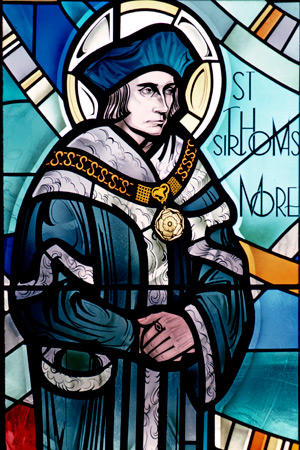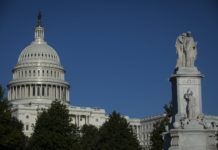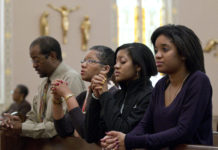If asked to list heroes of American freedom, people might reflect on the Revolutionary era and name George Washington, Nathan Hale and Betsy Ross. If asked to name heroes of religious liberty, they might go blank.

Religious liberty heroes are many and not limited to the 1700s, according to scholars at the University of Notre Dame. They cited St. Thomas More and St. John Fisher, Catholics who were both martyred in 1535; Roger Williams, the Puritan founder of Rhode Island who was a 17th-century proponent of religious toleration; James Madison, an 18th-century Founding Father; and Father John Courtney Murray, a 20th-century Jesuit priest.
Nor did they name only men. They also chose St. Elizabeth Ann Seton and St. Katharine Drexel, as well as Mary Dyer, a 17th century Quaker convert who was hanged by Boston’s Puritans for apostasy.
“The pioneers of religious life in America for women — starting with [Sister] Seton — had an indirect impact by establishing new forms of life and new institutional ministries, and thus calling for fresh thinking about religious liberty,” said Gerard Bradley, professor of law at the University of Notre Dame.
Richard W. Garnett, associate dean of Notre Dame Law School, nominated Dyer and said he would also “emphasize [Sisters] Seton and Drexel. After all, the great religious freedom fight in American history is the struggle by Catholics for Catholic schools.” St. Elizabeth Ann Seton opened the first free Catholic schools for the poor, and St. Katharine Drexel started the Sisters of the Blessed Sacrament whose mission was to teach African-Americans and later American Indians.
For preserving — and even defining — religious liberty for Americans, Bradley asserted that Madison had “as much to do as any other one person with the enactment of the First Amendment religion clauses [in the U.S. Constitution], so much the focal point of today’s debates about religious liberty.”
Bradley added that “Madison described the basis of religious liberty in terms indistinguishable from the way it is described in ‘Dignitatis Humanae’ (‘The Dignity of Human Persons’),” the document on religious freedom issued by the Second Vatican Council in 1965. Madison wrote that “religion or the duty which we owe to our Creator and the manner of discharging it can be directed only by reason and conviction, not by force or violence.”
Garnett holds that Madison, a framer of the Constitution, “believed that a specifically American model of religious freedom was emerging” in our new nation and that it would distinguish us, shape us and strengthen us. He and other leaders among the founding generation appear to have been keenly aware that they were attempting something new and great, something that would change — indeed, remake — the world.
“As we consider the state of religious freedom in America today,” Garnett said, “it cannot be emphasized enough that the protections provided in our constitutional text and tradition are not accidents, anomalies or anachronisms. In our traditions, religious freedom is cherished — and protected by the secular authorities — as a basic human right and non-negotiable aspect of human dignity.”
As for a hero of religious freedom who worked to influence both society and the church, the scholars all pointed to Father Murray. Father John O’Malley, also a Jesuit and a professor at Georgetown University, underscored that Father Murray critiqued both secular and Catholic views of religious liberty.
Though not a voting member of the Second Vatican Council, as an advisor to the bishops there, Father Murray was a significant influence. It was part of his long journey as a theologian.
“[Father] Murray tried to elaborate a theory that allowed for the American situation, that is, that allowed ‘freedom of religious choice’ as compatible with Catholicism,” said O’Malley. While Father Murray was initially silenced by the Vatican, he won out in the end when “the basic premises of his program were ratified in the council’s document on religious freedom, ‘Dignitatis Humanae.’”
Bradley termed the Jesuit “very important to the American story about religious liberty. Father Murray, by around 1960, was a standard reference for everyone in American society on what Catholics in America thought about religious liberty. His writings are still studied today.”
In Garnett’s view, “[Father] Murray insisted the American experiment should be seen as an attempt to secure religious liberty and authentic human flourishing through constitutional limits on interference by government with religion, and constitutional protection of the profession and practice of faith.”
In “Dignitatis Humanae,” Vatican II declared that “the human person has a right to religious freedom. This freedom means that all men are to be immune from coercion on the part of individuals or of social groups and of any human power, in such wise that no one is to be forced to act in a manner contrary to his own beliefs, whether privately or publicly, whether alone or in association with others.”
Saying so, the Council validated the lives, examples and work of More, Fisher, Williams, Madison, Seton, Drexel, Dyer and Murray.
– – –
By James Breig, retired editor of The Evangelist, newspaper of the Diocese of Albany, is the author of a new book, “Searching for Sgt. Bailey: Saluting an Ordinary Soldier of World War II” (Baltimore: Park Chase Press). Courtesy USCCB.




![[VIDEO] Make Sunday feel like Sunday again](https://www.catholicsun.org/wp-content/uploads/2021/04/2021-YOUTUBE-BISHOP-MESSAGE-THUMBNAIL-ENGLISH-218x150.png)
